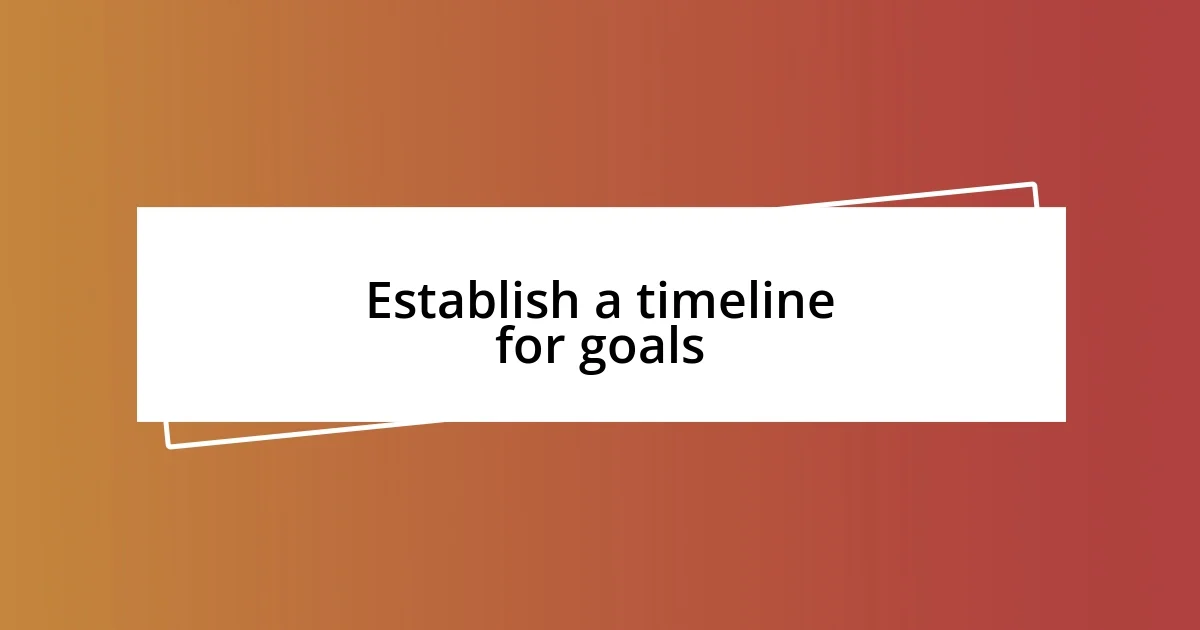Key takeaways:
- Establish clear goals to enhance focus, direction, and motivation; they help prioritize actions and manageable tasks.
- Regularly review and adjust goals to ensure alignment with evolving interests and priorities, fostering empowerment and adaptability.
- Utilize tools like prioritization matrices and timelines to organize tasks effectively, providing clarity and a sense of urgency in goal achievement.

Understand the importance of goals
Goals serve as the compass in our lives, guiding us toward the destinations we truly desire. Reflecting on my own journey, I recall a time when I felt utterly lost. Without clear goals, I drifted day by day, unsure of what I wanted. It was only when I started setting specific goals that I felt a renewed sense of purpose.
When I think about the importance of goals, I’m reminded of countless moments when I achieved something I once thought impossible. Each goal met brought not just success, but also an emotional reward—a surge of confidence and a reaffirmation of my capabilities. Have you ever experienced that rush? It’s addictive and compels us to reach for even more.
Goals also help us prioritize our actions and decisions. Without them, it’s easy to get sidetracked by distractions or to tackle tasks that won’t lead us anywhere meaningful. I’ve found that when I have a clear goal, my focus sharpens, and even the most daunting challenges become manageable stepping stones rather than insurmountable obstacles. How have your goals shaped your daily decisions?

Identify your top life areas
Identifying your top life areas is essential in setting meaningful goals. I’ve discovered that when I focus on the areas that matter most—like career, relationships, health, and personal growth—I can create a roadmap that resonates with my values and aspirations. For instance, taking the time to reflect on my relationships transformed my outlook, as I realized nurturing those connections brought joy that significantly influenced other areas of my life.
To effectively identify your top life areas, consider these aspects:
– Career: What do I want to achieve professionally?
– Relationships: How do I nurture connections with family and friends?
– Health: Am I prioritizing my physical and mental well-being?
– Personal Growth: What skills or knowledge do I want to acquire?
– Recreation: How do I balance fun and relaxation in my life?
By evaluating these life areas, I’ve been able to hone in on what feels most fulfilling. This process sparked a revelation for me: each area is interconnected, and focusing on one can uplift another. It’s a bit like creating a rich tapestry; all the threads contribute to the overall beauty and strength of the design.

Break goals into manageable tasks
Breaking down goals into manageable tasks is a strategy I find incredibly helpful. When I first realized the importance of this approach, I was overwhelmed by a long-term goal of writing a book. Instead of staring at that monumental task, I turned it into smaller pieces: researching topics, outlining chapters, and dedicating an hour each day to writing. Not only did this make the goal feel less intimidating, but it also allowed me to celebrate small victories along the way, which kept me motivated.
From my experience, keeping a list of tasks can transform chaos into clarity. I once had aspirations to get fit, but without a plan, I floundered. By breaking my goal into smaller tasks—like committing to a 20-minute workout three times a week and meal prepping each Sunday—I started seeing progress. It felt empowering to check those items off my list; each one became a stepping stone rather than a source of stress.
A practical example that I love to share relates to planning a big trip. When I dreamt of exploring Europe, the thought of planning everything felt daunting. I made a list of tasks: researching destinations, booking flights, and creating an itinerary. This method made the entire process enjoyable. Each task represented a piece of my adventure, and as I completed them, my excitement grew. Have you ever tried breaking a big dream down into little actions? It can truly transform your experience.
| Long-Term Goal | Breakdown Into Tasks |
|---|---|
| Write a Book | Research topics, outline chapters, dedicate daily writing time |
| Get Fit | Schedule workouts, cook healthy meals, track progress |
| Plan a Trip | Research destinations, book flights, create itinerary |

Create a prioritization matrix
Creating a prioritization matrix has been a game-changer for me when managing my goals. I’ve learned that visually organizing tasks based on urgency and importance can clarify where my focus should lie. For instance, when I placed my career advancements in one corner and personal health initiatives in another, it became clear that I needed to allocate more time to self-care, despite the daily pressures of work.
I remember the first time I used a prioritization matrix; it felt thrilling to map out my tasks and see everything laid out before me. I categorized my goals into four quadrants: those that are urgent and important, important but not urgent, urgent but not important, and neither urgent nor important. It was astonishing to realize how many tasks I had in the last quadrant—the ones I was stressing about that honestly didn’t matter as much as I thought. Have you ever experienced that? It’s liberating to shed the burden of unnecessary tasks.
Moreover, by consistently revisiting my prioritization matrix, I could recalibrate as my goals evolved. Last year, during a particularly busy season, I revisited my matrix and moved my community service goals into the “important but not urgent” quadrant, allowing me to focus more on work-related tasks without guilt. This balance is crucial; knowing I could return to my service activities later made all the difference in reducing my stress. What priorities might you adjust if you took a closer look at what truly matters?

Establish a timeline for goals
Establishing a timely roadmap for my goals has been essential in staying on track. I remember committing to a fitness journey; I set clear deadlines for each milestone, like running a 5K within six months. It didn’t just provide motivation—it created a sense of urgency that pushed me to show up for myself every day. Have you ever noticed how a deadline can ignite your focus?
As I worked through my writing projects, timing became my ally. I assigned myself weekly targets, like finishing a chapter or submitting articles, which kept my momentum alive. This isn’t just about managing time; it’s about fostering a rhythm that builds confidence. Each completed task felt like a mini celebration, amplifying my drive to tackle the next challenge. Do you have a timeline for your goals, and how does it influence your progress?
Thinking back, I find that flexibility within a timeline has served me well too. While planning my recent job search, I set a timeline for applying and networking, but I also allowed myself to adjust as new opportunities arose. This balance between structure and adaptability prevented me from feeling overwhelmed and opened the door to unexpected paths, proving that growth can be dynamic. How do you deal with changes along your journey?

Review and adjust goals regularly
It’s easy to become attached to our goals, especially when we pour time and effort into achieving them. However, I’ve come to realize that reviewing and adjusting those goals is just as essential as setting them in the first place. I recall a moment a couple of years ago when I was determined to complete a certification course. I threw myself into the material, but after my mid-term, I checked my progress and found that my interests had shifted. Have you ever found your goals evolving right under your feet?
In that instance, I decided to pivot, focusing my energy on personal projects that sparked my creativity rather than forcing myself through a program that no longer resonated. This honest reflection allowed me to align my goals with my current passions, and that felt empowering. I learned that reviewing my goals isn’t just about checking boxes; it’s about soul-searching and understanding what truly fuels me. What drives your passion behind your goals?
Regularly adjusting my goals has also kept me grounded during unpredictable times. Last month, when a family issue arose, I had to put my career goals on the back burner temporarily. I took stock of my life’s priorities and modified my plans accordingly. This shift not only eased my stress but ultimately reaffirmed my commitment to my long-term aspirations. Have you ever had to recalibrate your goals due to life’s unexpected twists? Making those adjustments reaffirmed my belief that goals should evolve with us.













